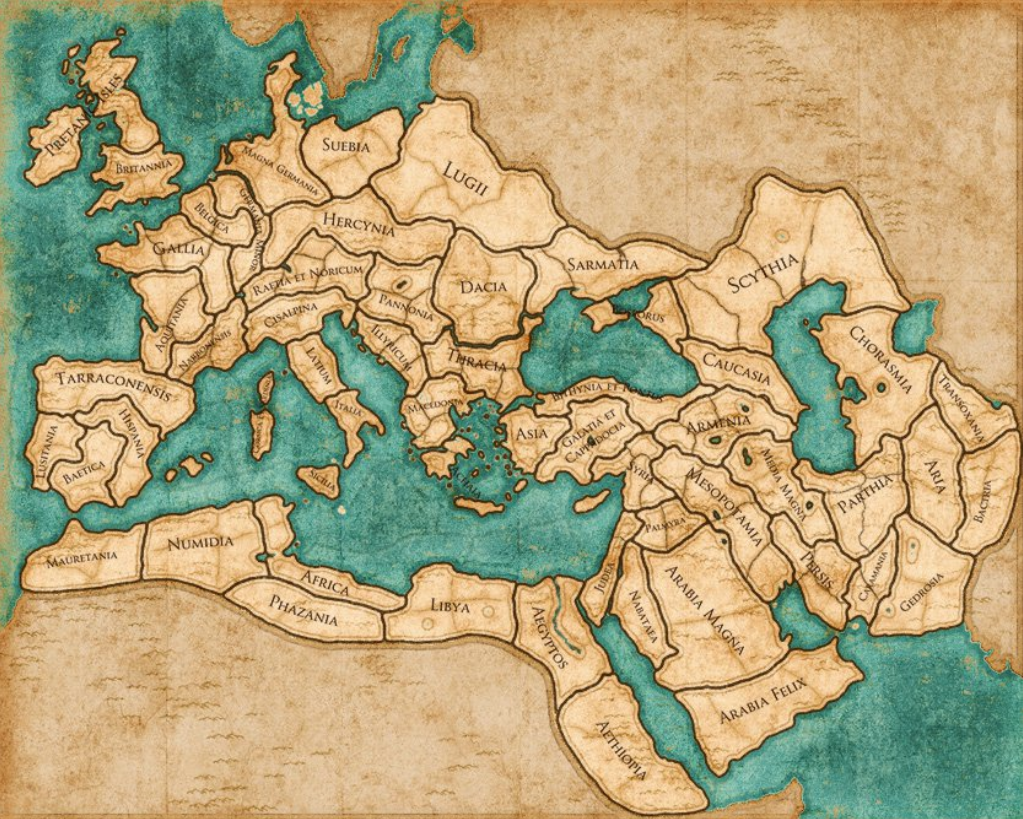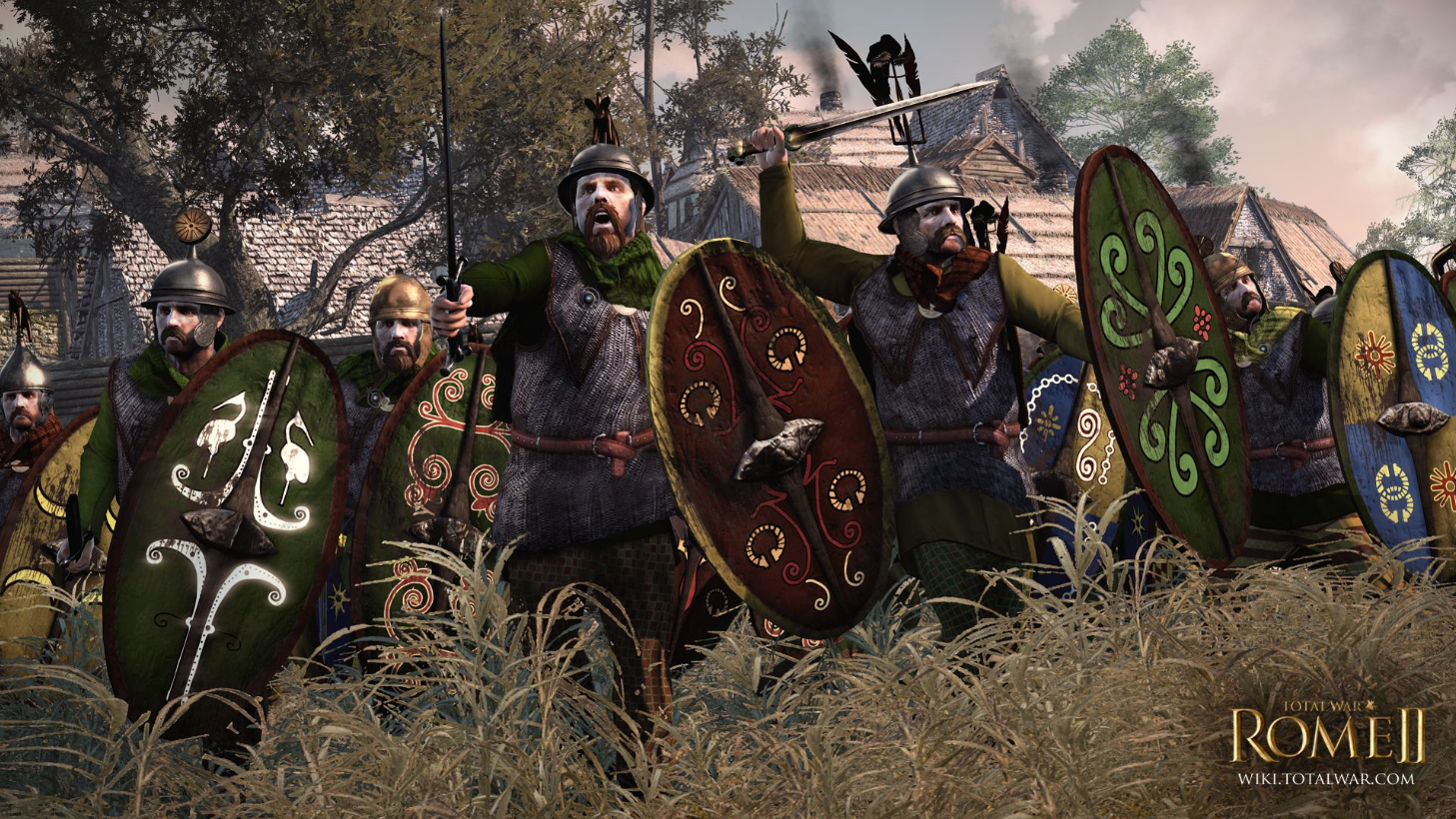Nobody’s Business but the Gauls? – Total War, the Iron Age and Popular Media
The game map for TW:R2
It is a truth increasingly acknowledged that video games are a potentially valuable medium of engagement and even education in the realms of history and archaeology. There is always the attendant issue of painstaking accuracy versus dramatic or aesthetic concerns in historical fiction (the perennial ‘Hollywood’ gripe).
Another, perhaps more intractable, problem, however, is how to build a video game around parts of the past for which our evidence is slim and our understandings thus limited. In attempting to create a working game system based on the world of the Late First Millennium BCE, the developers of the Total War series faced this problem head on with their entries Rome: Total War (2004) and its sequel/remake Total War: Rome II (2013).
For the uninitiated, the Total War series are PC-based strategy games, primarily in historical settings, that have players control a single nation or group (usually called a faction) over time, alternating between a turn-based campaign map (managing infrastructure, diplomacy, and grand strategy) and a real time approach to tactical command of armies in battle. This lends itself to an emphasis on the reconstruction of historical building and military unit types as a primary focus. Military history enthusiasts can recreate the armies, navies, equipment, and campaign experiences of the Napoleonic Era in lavish and loving detail, something in which the Total War series has indulged.
By contrast, an image of what a Roman legion c.100BCE would have looked like in action can only be cobbled together from oblique descriptions offered by historians like Polybius, Sallust, and Livy, as well as the extremely sparse archaeological remains left behind. When faced with the prospect of digitally representing an army of Gallic warriors, or any other force from northern Europe, in a similar timeframe, available sources are even fewer and less secure.
How the games handle the question of making functional and playable factions out of the inhabitants of Iron Age Europe c.275-1BCE make for a good case study of how attempts can be made to fill in the gaps in the historical record in an entertainment medium and to what extent this helps and/or hinders how players might effectively learn about the past.
RTW (2004) approaches the problem with caution and a tendency toward simplification. The factions of Gaul, Britannia, and Germania (lumped together from the multiplicity of historically attested groups from those areas) are portrayed with a limited array of buildings and unit types than their Roman or Greek counterparts which tend to be described in vaguer terms. Roman factions have settlements with options for multiple levels of fora, curiae, barracks, and amphitheatres and armies composed of hastati, triarii, and equites.
Meanwhile, their ‘barbarian’ counterparts simply have ‘marketplaces’, ‘taverns’, and ‘meeting halls’ as their building options alongside armies composed of units of ‘warband’, ‘swordsmen’, or even ‘barbarian cavalry’.
On the one hand, this approach has a certain honesty in reflecting the state of settled scholarship at the time of the game’s development. On the other, it obscures some of the information that we do have available to us. For example, ‘barbarian’ factions are limited in their available fortifications to basic wooden stockades around their settlements, despite the fact that monumental hillforts, characterised by vast, complex earthworks, raised ramparts, and mixed stone, timber, and mud-brick walls have been a key feature of Iron Age European archaeology since the late 19th century.
More problematically, this intentionally limited approach projects an impression of primitivism and backwardness, next to the ‘civilised’ factions of the game world, creating a potentially influential misrepresentation in the eyes of a public audience with limited access to wider resources on the topic.
Frustration with this presentation of Iron Age Gaul, Britain, Germania etc. was one of the main motivations for the creation of the mod Europa Barbarorum (Latin “Europe of the Barbarians”). Initially unable to prevail upon developers at The Creative Assembly, the makers of the mod sought to offer a far more comprehensive, historically accurate re-rendering of RTW’s game-world with extraordinary attention to detail.
In stark contrast with the base game’s lumping of ‘barbarian’ ethnic groupings into anachronistic conglomerate factions, EB attempts to recreate individual ancient polities in so far as we know of them.
Gaul, for example, is represented by the rival Aedui and Arverni nations (both prominent in wealth and influence in the Late Iron Age), while the Britons are represented by the Casse (aka Catuvellauni). Furthermore, rather than relying on generic designations, attempts are made at reconstructed Gaulish, Old Brittonic, and Proto-Germanic faction, unit, and building names; an impressive (though speculative) approach. The critical acclaim the mod developers’ efforts merited, and popularity within the historical gaming community, proved a significant influence on The Creative Assembly’s view towards a sequel.
Representation of the Gauls in TW:R2
One of the strengths of Total War: Rome II, therefore, is its move towards substantially greater accuracy and nuance. Following EB’s lead, the peoples of northern Europe are rendered as a plethora of small nations, rather than awkward, inaccurate conglomerations of Gauls, Britons, or Germani into single playable factions. These still present some issues of anachronism (notably in the use of the Iceni as the representative British faction) but are a decided improvement.
Similarly, there is a greater array of buildings and units on offer, still described in broad English terms but better grounded in archaeological evidence of large public meeting places, craft workshops, and religious sanctuaries. Fortified settlements match the appearance of well-examined archaeological sites (such as Bibracte, Gergovia, or Manching) far more closely than their predecessors. Although, different culture groups operate on slightly terms in campaigns for TW:R2 (attempting the reflect the diversity of social systems in the Ancient World), the ‘barbarians’ of the north and the ‘civilised’ peoples of the Mediterranean operate on a far more equal basis in terms of tiers of play.
Neither the mod nor the sequel game are without their flaws, however. An ironic issue raised by the latter is that due to certain quirks of their presentation, Gallic factions especially tend to be favoured by the metagame and AI as highly successful imperialists and conquerors. The game engine renders their primarily available troops (medium to heavy sword-armed infantry) highly effective, allows them readier access to buildings for mass production and artillery construction than their Roman or Greek counterparts, and, through the ‘confederation’ mechanic, allows them to absorb their neighbours (along with their military and economic resources) through diplomacy rather than brute conquest and subjugation.
This can lead to situations wherein a Gallic imperial hegemony over the Ancient World is less an intriguing historical counterfactual than a matter of reasonable probability in the game world.
The problem then is the obfuscation of the complex and specific logistical and ideological factors that birthed the Roman Empire in favour of an anachronistically open-ended, winner-takes-all portrayal of the situation.
The major flaw of the EB mod as a tool for historical engagement, on the other hand, is its lack of easy accessibility for casual and non-academic audiences. Even beyond its status as a mod rather than mainline game, EB’s emphasis on painstaking realism makes it a highly challenging, slow-moving game to play (especially for factions from Britannia or Germania), requiring a fair amount of familiarity and skill with its base game to effectively engage with.
Similarly, while its provision of the player with large chunks of supplementary text may be highly informative, they are not the easiest to digest, especially for those not directly motivated to investigate them. Whereas both RTW and TW:R2 can engage gamers of most skill-levels and introduce them to aspects of historical fact along the way, EB is specifically aimed at the niche Venn diagram of advanced Total War players who also happen to well-informed, highly interested history enthusiasts to begin with.
Ultimately, the Total War games are an imperfect tool for public engagement with the history and archaeology of the Ancient, and especially Iron Age European, World. They hopefully spark interest and a desire to investigate further in players, but, due in large part to mechanical limitations, cannot provide a clear and comprehensive introduction to the material on their own.
In some ways this makes the release of the Remaster of RTW, reviving the poorer, more anachronistic portrayals of the ‘barbarians’ of Iron Age Europe, and its apparent popularity after the decidedly mixed reception of TW:R2, a worrying development.
Ralph Moore is a PhD Candidate in the Department of Classics at Trinity College Dublin. His research looks generally at cultural interactions between the Ancient Mediterranean and north-western Europe, and is particularly focused on how Roman rule affected social hierarchy and mobility amongst the Gallic peoples of the Rhone Basin.



